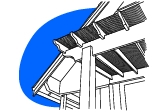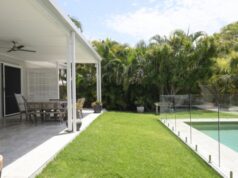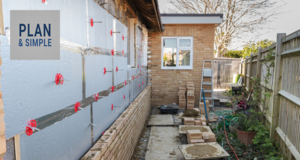
Acrylic sheeting is often used on pergola roofs to provide affordable protection from the elements in a range of styles and textures. Acrylic sheeting can be either opaque, or clear to let light in.

What are acrylics?
Acrylic is a generic name for rigid plastics made from a substance called ‘polymethyl methacrylate’. Other popular names include more recognisable brandnames, including Plexiglas, Perspex and Lucite. This material has the greatest transparency of any material (even more than glass) and will allow UV to pass right through it, meaning that it won’t yellow over time. Acrylic is used in many applications such as motorcycle helmet visors, large aquariums and the bulletproof “glass” protecting bank tellers.
Acrylic roofing is strong, lightweight and very easy to work with, though can be vulnerable to cracking if it’s put under too much pressure. Acrylic can be tinted to change the colour of the light it lets through, creating dazzling effects at different times of the day.
How do acrylics and polycarbonates differ?
Although they are commonly confused, polycarbonates (also known under common brand name Lexan) should not be mistaken for acrylics. Other uses for polycarbonate include CDs and DVDs and laptop shells. Acrylics and polycarbonates are very similar materials, but polycarbonate will block out UV rays and as such, will yellow with time and sun exposure. It is much less likely to crack though, and is therefore much easier to install.

What function do acrylic roofs serve?
Though it won’t provide a great deal of shade, acrylic roofing will block out any rain, hail or other falling materials like leaves and branches from tall nearby trees. Acrylic’s a good option if you want to ensure that you’re allowing as much light as possible through into your pergola.
How is it attached?
The acrylic sheeting is attached to the pergola roof on the battens. It is best to lay down some noise tape along the battens first; this prevents the sheets from rattling in the wind and creaking in the heat. The first sheet is aligned with the outside of the frame, and the rest is installed working across the middle to the other edge. Special fixings are required for acrylic sheeting to ensure it is cushioned – these have a bolt head on top, a specially shaped rubber washer and a screw bottom which drills into the wood.
What variations exist?
There are a number of different shades available for acrylic and polycarbonate roofing, as well as a variety of corrugation variations. Many brands will market the exact same type of plastic under a different name to their competitors, so be aware that large variations in price may not equal a large difference in terms of product quality or production standards.





